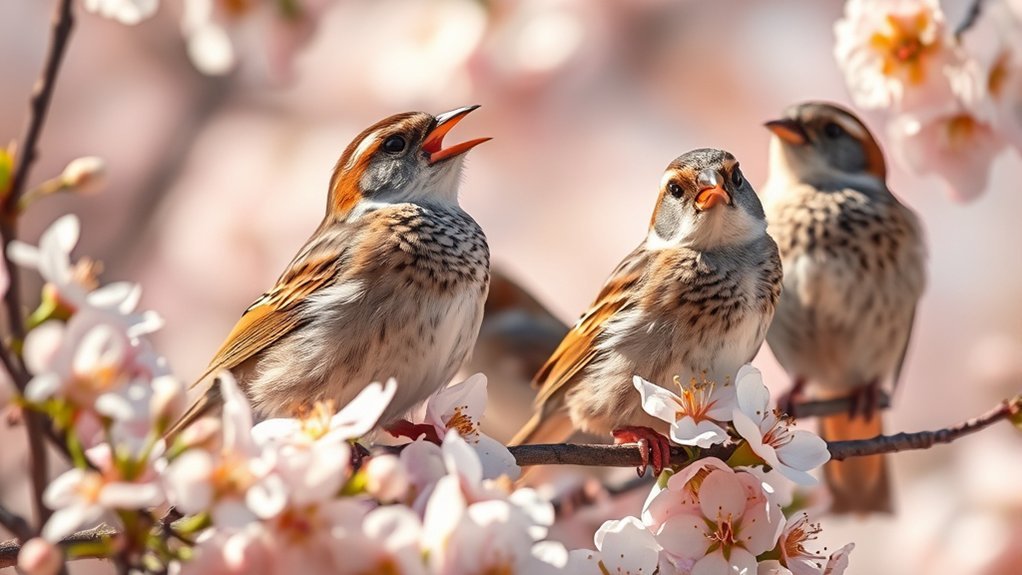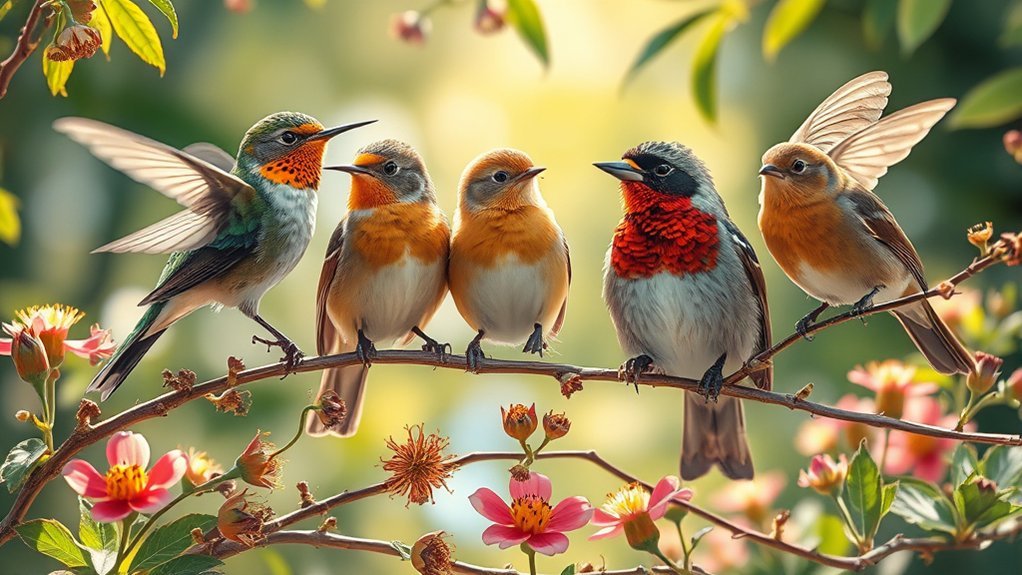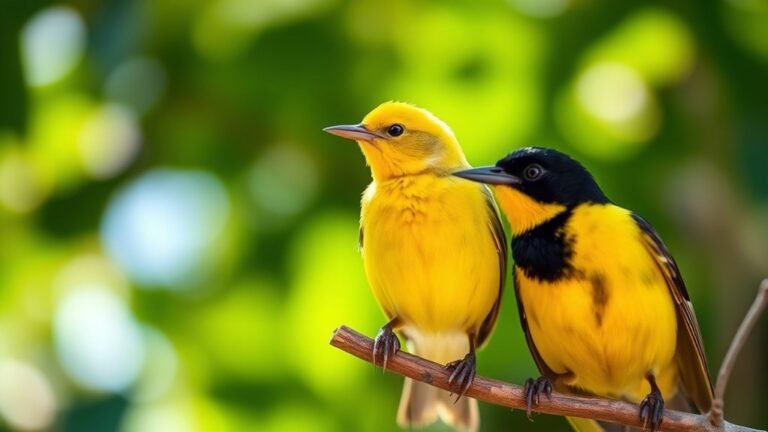Exploring Different Types of Songbirds
As you learn about songbirds, you'll see how different they are from each other. Each kind of songbird, like sparrows and warblers, has its own special song and home. Their songs fill the air in forests and yards, and they help birds attract mates and claim their space. This sound and behavior show how these birds stay alive and thrive. There's still a lot to discover about how they live with and adapt to their surroundings.
A Quick Overview
Songbirds, like sparrows, nightingales, and warblers, are really interesting creatures. They live in different places and show many types of behaviors. This helps us learn more about nature.
Sparrows are great at living in cities. They often stick together in groups and use chirps and tweets to talk to one another. They are very adaptable and can thrive in these busy environments.
Nightingales are famous for their lovely songs. These beautiful sounds are often linked to love. Male nightingales sing to attract female mates in thick forests where they live.
Warblers are known for their long journeys. They travel far and wide, which excites birdwatchers. Warblers have bright colors and lively movements as they hunt for insects to eat.
Songbirds are important in many ways. They help plants by spreading seeds and pollinating flowers. They also help keep other animal populations balanced. Their actions contribute to a healthy ecosystem.
The Enchanting World of Sparrows

Sparrows might be small and easy to miss in the busy city, but they're really interesting birds.
There are over 35 types of sparrows, and they can live in many different places, especially in cities.
City sparrows have learned to live near people. They create their own groups and find food scraps and places to nest in buildings. They work together to find food and use sounds to talk to each other, which helps them stay close as a group.
Sparrows are strong and clever. They face many challenges in the city but manage to survive and thrive.
Watching sparrows can teach us about how nature works even in busy places. They can help us connect more with our city and the world around us.
The Melodic Charm of Nightingales

The nightingale sings beautiful songs that many people love to hear. Its sweet melodies are often a sign that spring has arrived. You can find nightingales in thick forests and bushes, where they feel safe among the trees.
Nightingales are symbols of love and romance. People often write about them in stories and show them in art. Their songs fill the quiet evenings, making us feel more connected to nature.
The nightingale's songs aren't just pretty; they also help them find mates and claim their territory. These birds are more than just singers; they represent strong feelings and connections in our lives.
The Colorful Presence of Warblers

Warblers are small birds that can be easy to miss because they're often outshined by other songbirds.
However, they're truly special with their bright colors and lively actions. These little birds are a joy to watch for anyone who loves nature.
Warblers travel long distances when they migrate. Some of them may fly thousands of miles from where they breed to where they spend the winter.
Learning about their migration helps us appreciate how strong and brave they are.
When you see warblers, pay attention to what they eat. They like to munch on insects and spiders.
They're excellent fliers and can catch their food while flying in the air.
As you enjoy watching these birds, think about how their colorful feathers and unique habits make the birdwatching experience fun.
Warblers create a connection among those who love nature, making each viewing special with their beauty and energy.
The Unique Sounds of Thrushes
Thrushes are special birds that sing beautiful and catchy songs. They belong to a group of songbirds that people really enjoy listening to. Their songs often have patterns, with repeating phrases that make them sound lovely and full of life.
During thrush migration, you can hear their songs echoing through the woods. These sounds help thrushes communicate with each other. Each type of thrush, like the song thrush or the hermit thrush, has its own unique sound. This makes their melodies different, so you can tell them apart when you listen closely.
When you take a moment to enjoy these delightful songs, you'll see how important thrushes are in nature. You might even find yourself connecting with other bird lovers who share your interest.
Enjoy the music of thrushes and appreciate the beauty they bring to our world!
The Delightful Tunes of Finches
Listening to finches is a real treat. Their bright and happy songs fill gardens and woods. You can hear them in fields and thick bushes. Their cheerful tunes light up the morning.
Finches are small birds that share a variety of notes. They use these notes to mark their territory and to attract mates. Each species has its own special song. These songs show their presence and add joy to the sound around us.
Watching finches as they move through their homes helps us connect with nature. It also builds a sense of community among people who love birds. Enjoying these lovely birds can bring us all together.
The Social Behavior of Chickadees
Chickadees have very interesting social behaviors. They live in groups and communicate with each other using specific sounds. This communication helps them work well together and stay safe from predators. While foraging, or looking for food, chickadees stick close together. This teamwork makes them more efficient and helps protect them from danger.
Chickadees are also great parents. They take care of their nests and defend their territory from other birds. When the seasons change, they might move to different areas and meet new flock members. This change can affect their social groups and how they interact.
When chickadees see a predator, they've a special way to warn each other. They let out specific calls to alert their friends. These social behaviors help chickadees feel like they belong and work together, which is important for their survival.
Learning about how chickadees interact can give you a deeper appreciation for these charming little birds. They've a lot of character and a strong sense of community!
The Iridescence of Blackbirds
Have you ever seen how blackbirds' feathers shine in the sunlight? That bright shimmer comes from tiny structures in their feathers. These structures bend light and create beautiful colors.
Blackbirds live in different places like wetlands, fields, and woods. Their shiny feathers help them in many ways. During mating season, male blackbirds show off their bright feathers to get the attention of females. This display shows that they're strong and healthy.
The shiny feathers also send messages to other male blackbirds. This helps them communicate and understand their place in the group.
Watching these birds in nature can help you appreciate how beautiful they're and how they interact with each other.
The Whispering Calls of Swallows
Swallows have a special way of charming us with their sweet calls that fill the air. These sounds are important for their friendships, especially when they're looking for mates. As swallows travel long distances, sometimes thousands of miles, their calls help them stay close to each other.
When it's time to build nests, swallows show how clever they are. They make mud nests under roofs and use their calls to work together as a team and mark their spaces. Their sounds and their actions help them feel connected to each other.
Watching swallows fly gracefully and listening to their soft calls gives us a glimpse into their lives. They blend their calls and long trips into a beautiful mix that keeps them safe and close to their friends.
The Vibrancy of Tanager Species
Tropical tanagers are stunning birds with bright colors that grab your attention right away. You can see deep blues, bright reds, and sunny yellows on their feathers.
These colors are important for finding a mate. Male tanagers show off their beautiful plumage to impress females during courtship. Their colors play a key role in their love lives.
Different tanager species have different colors, which can tell us what they eat and where they live.
Social behavior is interesting too. The bright colors help tanagers connect with each other in their flocks.
This colorful display adds to the overall beauty of songbirds and makes tanagers stand out in the bird world.
The Boldness of Cardinals
Cardinals are beautiful birds with bright red feathers. They stand out and catch the eye of anyone who sees them. Their behavior shows they're confident and energetic. People often admire cardinals because they represent love and warmth.
Cardinals are known for their loud and bold calls. They use these sounds to talk to other cardinals, marking their territory. If you see a cardinal, it may not just be a random sighting—it can feel special and meaningful.
These birds are also great at living in busy cities. They adapt well to different environments, showing how strong they can be.
Understanding what cardinals represent can help you appreciate them even more. Each encounter with a cardinal can bring a sense of joy and connection.
The Echoing Voices of Mockingbirds
How do mockingbirds impress everyone with their amazing singing? These little birds can mimic the songs of over 200 different birds. When you're in a city park, you might hear a mockingbird singing happy tunes along with the sounds of cars or kids playing. They mix nature with city life in a fun way.
Mockingbirds sing for important reasons. They use their songs to claim their space and to attract partners. It can be fun to listen and try to guess who they're imitating. Each time you hear them, it's like a mini concert, turning a regular moment into something special.
In a world filled with buildings and noise, mockingbirds show us the beauty of nature. Their songs help us feel more connected to the world around us.
The Diverse Habitats of Buntings
Buntings live in many different places, showing how well they can adjust to their surroundings. You can spot them in grasslands, brushy areas, and even in forests. They like to build their nests close to the ground, using thick plants to keep them safe.
When it comes to food, they aren't picky. They eat seeds and insects, depending on what's nearby.
- Buntings like open spaces with some cover for nesting and finding food.
- They can easily adapt to new places, which helps their numbers stay steady.
- They search for food in smart ways, allowing them to take advantage of different meals wherever they are.
Buntings are colorful and fun to watch. Their sounds fill the air, adding joy to nature. Observing these birds can be a delightful experience!
The Role of Songbirds in Ecosystems
Songbirds are important for keeping our ecosystems healthy. They help control other animal populations and connect different species in the food chain. By eating nectar, songbirds assist with pollination. This helps plants grow and reproduce.
When you listen to their cheerful songs, remember that they help attract mates and mark their territory. They also migrate, spreading seeds as they travel, which supports plant diversity.
Songbirds add beauty to our surroundings and play a vital role in nurturing nature.
When we recognize their importance, we can appreciate the fragile balance that keeps our environment thriving.
Frequently Asked Questions
How Do Songbirds Adapt to Urban Environments?
Songbirds are interesting creatures. They do well in cities because they change their habits. For example, they find places to nest in buildings. This helps protect them from bad weather and other dangers.
Songbirds also find food in urban areas. They eat food from gardens and sometimes from trash. This gives them plenty to eat, which helps them survive and have baby birds.
What Conservation Efforts Exist for Endangered Songbird Species?
To help endangered songbirds, people work on two main things: keeping their homes safe and watching their numbers.
First, habitat preservation means protecting the places where these birds live. When their homes are safe, the birds can find food and raise their babies.
Second, population monitoring is like counting how many birds are out there. By tracking their numbers, people can see if the birds are doing better or worse. This information helps everyone know what to do to help them grow in numbers again.
Together, these efforts ensure that endangered songbirds have a better chance of surviving and thriving in the wild.
How Can I Attract Songbirds to My Garden?
To bring songbirds to your garden, start by putting up bird feeders. Fill them with seeds that birds love. You should also plant native plants. These plants give birds both food and shelter. With feeders and plants together, your garden will become a welcoming place for songbirds. It will make your outdoor space lively and full of nature. Enjoy watching the birds as they visit!
What Are the Differences Between Male and Female Songbirds?
Male and female songbirds look different. Males usually have brighter colors in their feathers. They also sing differently. Male songbirds sing more and often have complex songs. They do this to defend their territory and attract female mates. This singing helps them in their role of finding a partner. Female songbirds may not sing as much, but they play a vital role in choosing a mate.
How Do Songbirds Communicate With Each Other?
Songbirds use their voices to talk to each other. They make different sounds to show where they live and to find friends. These songs help them make connections with other birds in their group. Watching them sing and chatter in nature is really amazing!

Luna is the passionate founder and author of Birds and You, a website dedicated to sharing her love for birds with fellow enthusiasts. Through her engaging articles and guides, she aims to educate and inspire others to explore the fascinating world of birds. When she’s not writing, you can find Luna observing birds in their natural habitats or sharing beautiful bird photography on Pinterest. Join her on this journey to celebrate and protect our feathered friends!







